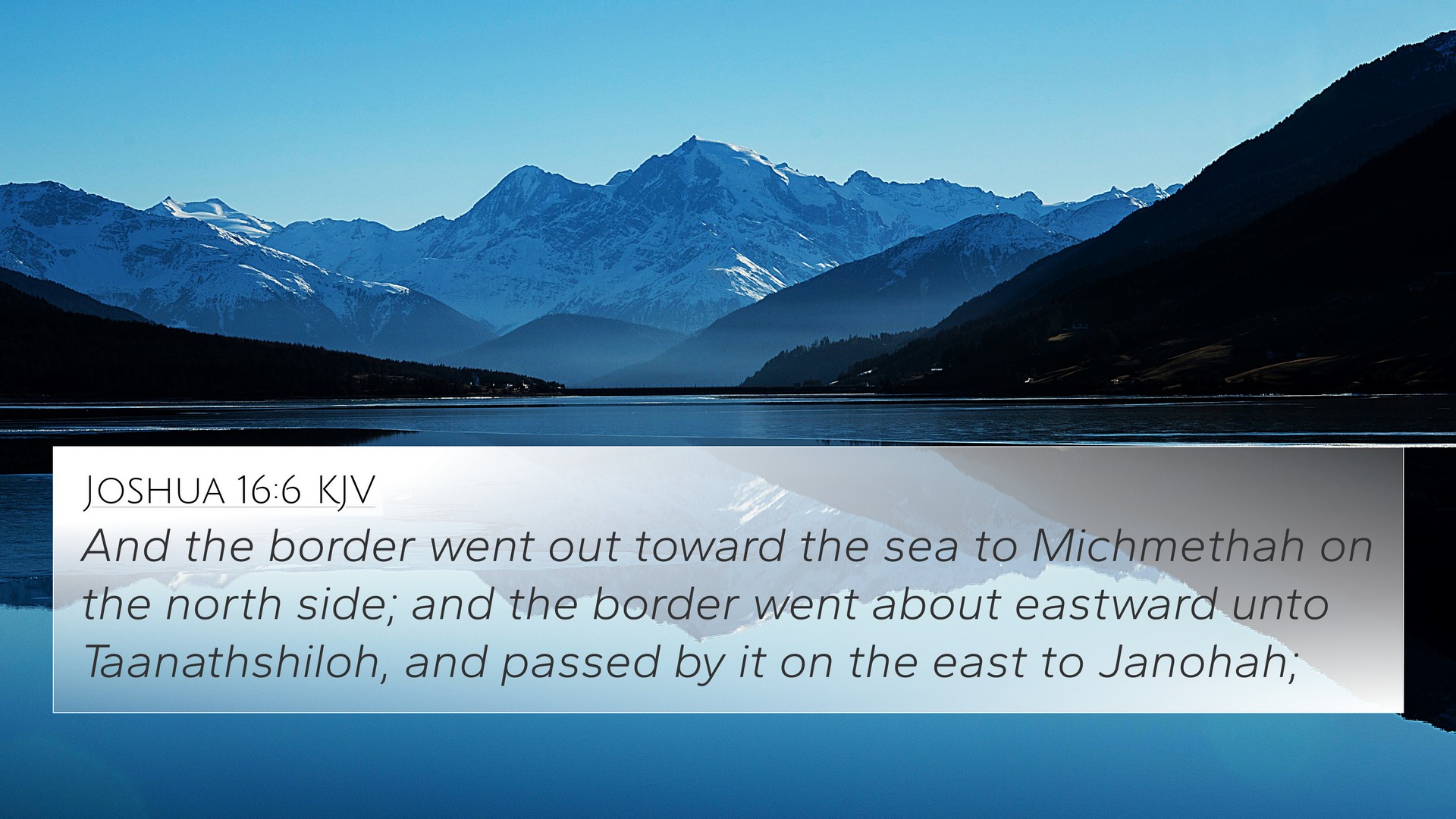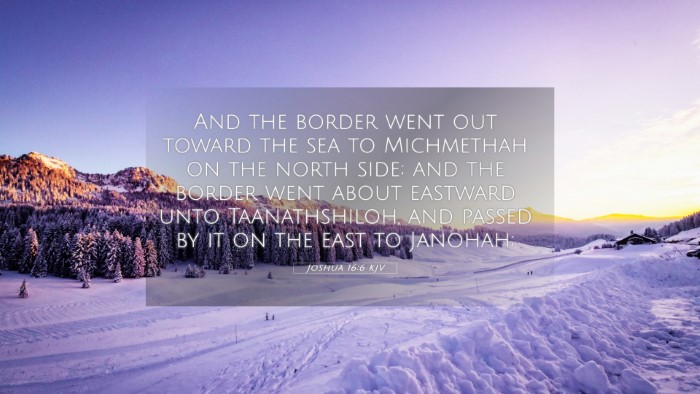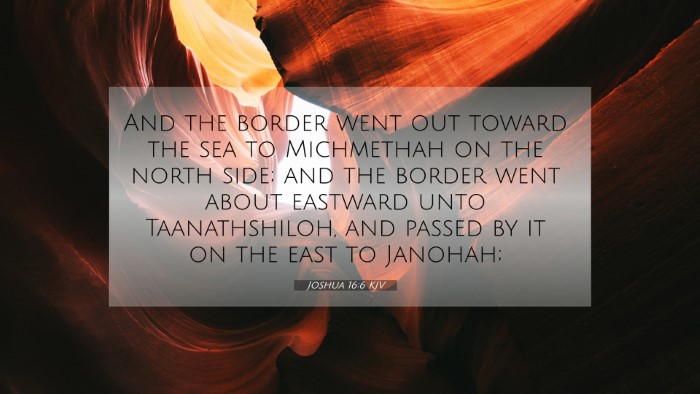Old Testament
Genesis Exodus Leviticus Numbers Deuteronomy Joshua Judges Ruth 1 Samuel 2 Samuel 1 Kings 2 Kings 1 Chronicles 2 Chronicles Ezra Nehemiah Esther Job Psalms Proverbs Ecclesiastes Song of Solomon Isaiah Jeremiah Lamentations Ezekiel Daniel Hosea Joel Amos Obadiah Jonah Micah Nahum Habakkuk Zephaniah Haggai Zechariah MalachiJoshua 16:6 Similar Verses
Joshua 16:6 Cross References
And the border went out toward the sea to Michmethah on the north side; and the border went about eastward unto Taanathshiloh, and passed by it on the east to Janohah;
Uncover the Rich Themes and Topics of This Bible Verse
Listed below are the Bible themes associated with Joshua 16:6. We invite you to explore each theme to gain deeper insights into the Scriptures.
Joshua 16:6 Cross Reference Verses
This section features a detailed cross-reference designed to enrich your understanding of the Scriptures. Below, you will find carefully selected verses that echo the themes and teachings related to Joshua 16:6 KJV. Click on any image to explore detailed analyses of related Bible verses and uncover deeper theological insights.
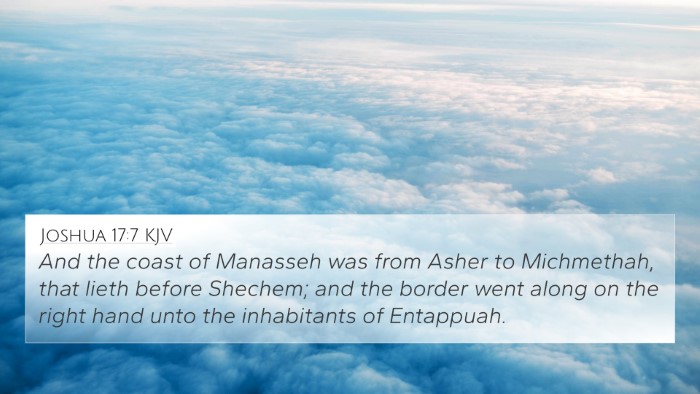
Joshua 17:7 (KJV) »
And the coast of Manasseh was from Asher to Michmethah, that lieth before Shechem; and the border went along on the right hand unto the inhabitants of Entappuah.
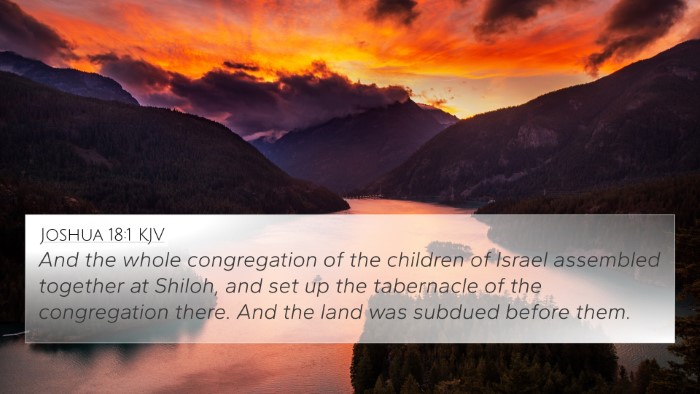
Joshua 18:1 (KJV) »
And the whole congregation of the children of Israel assembled together at Shiloh, and set up the tabernacle of the congregation there. And the land was subdued before them.
Joshua 16:6 Verse Analysis and Similar Verses
Understanding Joshua 16:6
Joshua 16:6 states: "And the border went out toward the sea to Michmethah on the north side; and the border went around eastward unto Taanath-shiloh, and passed by it on the east to Janoah;" This verse provides detailed information regarding the boundary measurements of the territory assigned to the tribe of Ephraim. The intricate language and geographical references highlight both the historical context and significance of land distribution in Israel.
Context and Significance
The significance of land division is central to the narrative of Joshua, where the Israelites settle in the Promised Land. Various public domain commentaries shed light on this verse, emphasizing its relevance for understanding God's promises and the faithfulness of the Israelites in claiming what was divinely allotted to them.
Commentary Insights
- Matthew Henry: Henry emphasizes Israel’s obedience in dividing the land as a fulfillment of God's promise to their forefathers. The detailed geographic markers, such as Michmethah and Taanath-Shiloh, illustrate God's meticulous planning in fulfilling His covenant.
- Albert Barnes: Barnes focuses on the precision of the borders and how they symbolize the boundaries of God's blessing. He notes the importance of being aware of one's territory in the spiritual sense, as boundaries can also signify a commitment to God’s commandments.
- Adam Clarke: Clarke elaborates on the historical significance of the locations mentioned, acknowledging that they provide a physical representation of the spiritual inheritance of the Israelites. He underscores the importance of land not merely as a possession but as a promise fulfilled by God.
Bible Cross-References
In studying Joshua 16:6, several other scriptures can provide contextual insights and thematic connections:
- Joshua 17:15 – Highlights the expansion of the territory and the challenges faced by the tribes in occupying their land.
- Genesis 48:19 – Discusses Jacob's blessings over Ephraim, linking the tribe’s inheritance to God's overarching plan.
- Numbers 34:3-5 – Provides a broader picture of the land borders assigned to the tribes of Israel.
- Deuteronomy 1:8 – Reminds the Israelites of God's command to take possession of the land, establishing the foundation for territorial discussions.
- Psalm 78:67 – References God's choice of Judah over Joseph, paralleling the allocation of land among the tribes.
- Joshua 14:1-5 – Continues the narrative of land division and highlights the allotment process among the tribes.
- 1 Chronicles 5:23 – Mentions the prosperity of the tribe of Ephraim in their allotted territory.
- Hebrews 11:9-10 – Connects the promise of land to faith, reiterating the spiritual significance of the physical inheritance.
- Revelation 21:2 – Offers a visionary connection of God's ultimate promise with the new creation, echoing themes of inheritance.
- Matthew 2:23 – Points to prophetic fulfillment regarding location, illustrating thematic continuity between Old and New Testaments.
Connections to Other Bible Verses
This verse can also serve as a bridge to connect multiple Biblical themes, such as God's promises, divine leadership, and the importance of obedience:
- The themes of inheritance and possession in Galatians 3:29, where Paul explains believers' inheritance through faith in Christ.
- Linking Joshua's leadership in securing physical land (Joshua 1:3) to Jesus' leadership in securing salvation for humanity.
- Connecting the land allocations in Joshua with the concept of spiritual territories discussed in Ephesians 6:12, highlighting the Christian's struggle for righteousness.
Thematic Bible Verse Connections
Thematically, Joshua 16:6 resonates with the idea that God is intentional in His planning and provisions. This can encourage believers to recognize that their spiritual inheritance is grounded in God's promises:
Key scripture passages that highlight similar themes include:
- Isaiah 54:17 – Assurance that no weapon formed against God’s people shall prosper, reinforcing God’s protection over His promises.
- Ephesians 1:11 – Emphasizes that believers are chosen and predestined according to God's purpose, paralleling the chosen people in the Old Testament.
Conclusion
Joshua 16:6 is not just a historical account; it serves as a vital link in the broader narrative of the Bible. The detailed borders signify God's faithfulness, the fulfillment of His promises, and His intent to dwell with His people. This verse invites readers to explore the intricate thematic cross-references that enrich the understanding of the entire Biblical text.
For those utilizing bible concordance or bible cross-reference guides, recognizing these connections can deepen one's study and appreciate the cohesiveness of scripture throughout the ages.
